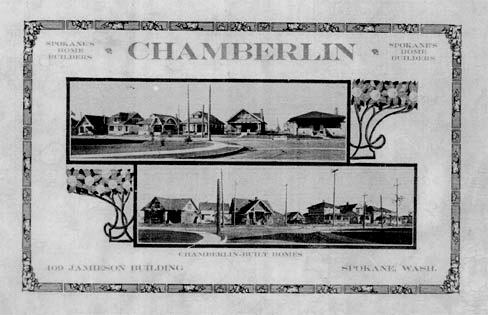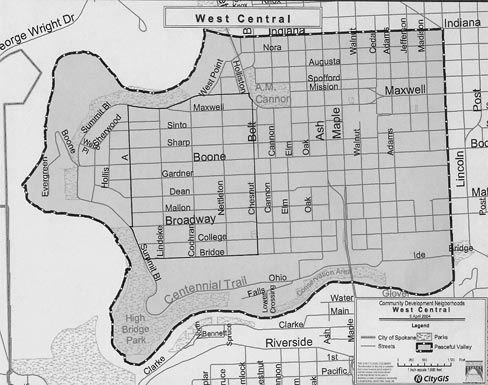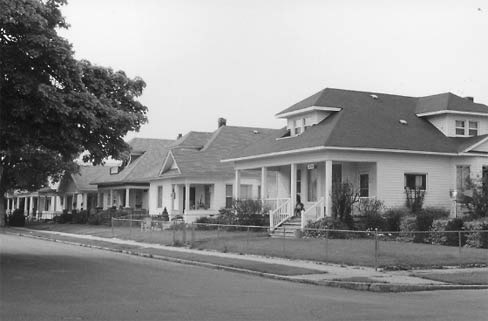Research Report
Nettleton's Addition Historic District in Spokane, Washington
by Diana J. Painter and Kevin Brownlee
Nettleton's Addition Historic District in Spokane, Washington, is a success story about the effectiveness of the National Register of Historic Places as a planning and historic preservation tool. In this Pacific Northwest city of approximately 200,000 people, a National Register listing changed community perceptions of a neighborhood from "Felony Flats" to "the hottest little area in town," according to local realtors. Corporate developers, citizen volunteers, and nonprofit and governmental agencies worked together to create Washington State's largest National Register historic district; the local government enacted precedent-setting legislation to protect it.(1)
Developed between 1907 and 1911 during a period of extensive population growth and expansion in the Pacific Northwest, Nettleton's Addition epitomized the early 20th-century American streetcar suburb, from its dense assemblage of single-family homes to its orderly pattern of lots, blocks, and alleys.(2)(Figure 1) It was first served by a cable car and later an electric streetcar line (the tracks are embedded in the pavement) that terminated at the city's Natatorium Park, a popular regional playground and recreation area.
The houses in the neighborhood—most of them based on designs published in architectural pattern books—mark the change in architectural tastes from the late Victorian to the early Arts and Crafts periods. Individual property owners and small contractors built most of the houses in the neighborhood, though several blocks have been attributed to one pattern book company—the Chamberlin Real Estate and Improvement Company.(Figure 2) The Chamberlin Company provided not only house plans but also loans and mortgages for prospective home buyers. Gilbert Chamberlin, one of the company's founders, was no novice in real estate development, having built suburban neighborhoods in Kansas, California (specifically Los Angeles), and Utah before coming to Spokane.
 |
Figure 2. The Chamberlin Company supplied house plans and loans and mortgages for prospective home buyers in Nettleton's Addition. (Courtesy of the author.) |
The developer William Nettleton's local political connections are to account in part for this neighborhood's and Spokane's growth during this period. Nettleton and his colleagues sat on the board of the local power company, which supplied electricity for the streetcars. They also served on the boards of the traction companies and speculated in real estate along proposed streetcar routes. Many of them provided mortgages for the homes built in the new suburbs. Their influential network ultimately built the city's first ring suburbs and park system.
Nettleton, who lived out the remainder of his life in Nettleton's Addition, had established new communities in the Midwest before coming to the Pacific Northwest. He founded the towns of Superior, Wisconsin, and, with others, Duluth, Minnesota, before developing a streetcar suburb in St. Paul, Minnesota. He served as the first representative of St. Louis County in the Minnesota State Legislature and, in that position, lobbied for westward expansion by rail. He donated 65 acres for a depot in Duluth to secure what became the eastern terminus of the Northern Pacific Railroad. He used his political connections with the Northwestern Railroad to buy 270 acres from the company in Spokane, the future site of the area that now bears his name.(Figure 3)
 |
Figure 3. The Nettleton's Addition Historic District includes more than 38 square blocks of early 20th-century houses in Spokane's West Central neighborhood. (Courtesy of the author.) |
This project began in 2002 when the West Central neighborhood in which Nettleton's Addition is located set aside $10,000 in U.S. Department of Housing and Urban Development (HUD) community development block grant funds for a National Register district nomination.(3) A development project proposed for an area adjacent to Nettleton's Addition concerned the neighborhood council, which feared the loss of historic single-family houses bordering the development site. In consultation with the Washington State Department of Archaeology and Historic Preservation (DAHP), the council and the city of Spokane decided that Nettleton's Addition was an appropriate location for a historic district.
Work began in the spring of 2003 on historic property surveys of the area. The first survey focused on one platted section known as Nettleton's Second Addition. It became apparent, however, that the historic context better suited the entire Addition, not just one section of it. The council, city, and DAHP decided to include the whole subdivision in the nomination, which ultimately resulted in an inventory of nearly 1,000 houses and more than 600 accessory structures.(4) During the survey, the authors and city preservation specialist Aimee E. Flinn developed criteria for evaluating the significance of each property and whether it was contributing or non-contributing to the district. The neighborhood had deteriorated over time, and it was important to have clear and consistent criteria in support of the nomination.
The project team completed the inventory in late 2005. The authors, meanwhile, prepared the National Register nomination, which incorporated a summary of all 1,592 resources in the district, including the property's location, ownership, key historic data, architectural style, significance, and integrity.(5) Nettleton's Addition was listed in the National Register of Historic Places in March 2006.
Speculative acquisition and demolition of Nettleton's properties near the development area was a major concern. Leveraging Nettleton's historic designation, the neighborhood worked with the City of Spokane Planning Department to rezone the area. In the late 1970s, Nettleton's had been rezoned for high-density, multi-family development, though that zoning had rarely been utilized and the historic housing stock survived. In 2006, the Spokane City Council "down-zoned" the entire area from multi-family to single-family use in order to protect the integrity of the district. Spokane's newly enacted demolition ordinance, which requires plans for construction of a replacement structure prior to the issuance of a demolition permit for a contributing structure within a historic district, also helped curtail speculative demolition.
The National Register listing was the high point in the process of turning around Nettleton's Addition. The neighborhood and city used the neighborhood's historic status to promote participation in the local tax benefit program and a variety of other revitalization projects and activities. News of its status as the largest National Register district in Washington State has generated positive statewide publicity and changed local perceptions of the neighborhood.
The research carried out for the National Register nomination successfully illuminated the historic importance of the neighborhood to the city of Spokane and placed this Pacific Northwest streetcar suburb in context. The history of Nettleton's Addition is now a point of local pride. The century-old neighborhood continues to extend the same lifestyle benefits to a new generation of residents.
About the Authors
Diana J. Painter, Ph.D., is the principal of Painter Preservation & Planning, a historic preservation consulting firm based in Petaluma, California. Kevin Brownlee works for the City of Spokane's Department of Community Development and as liaison to the West Central Neighborhood Council.
Notes
1. The authors worked with Teresa Brum, the historic preservation officer in the City-County of Spokane Historic Preservation Office, and preservation specialist Aimee E. Flinn on this project. More about Nettleton's Addition is available online at http://www.spokanepreservation.org/.
2. This development pattern was not unique to Nettleton's Addition or to the city of Spokane. Cities across the United States experienced similar population growth and expansion during this period, due in part to the influx of immigrants and people from rural areas who had come to the cities in search of work.
3. Author Brownlee was instrumental in obtaining the HUD grant, as well as securing funding from developer Nitze-Stagen & Company. Brownlee, a resident of the neighborhood, also assisted with the survey and research for the nomination, as well as contributing to this article.
4. Funding for the extended survey came from several sources. Seattle-based developer Nitze-Stagen & Company, which had taken control of the development project at the south end of the neighborhood, pledged matching grant monies, as did Spokane Preservation Advocates. Washington State's Office of Trade and Economic Development also contributed.
5. The nomination was completed in September 2005.

